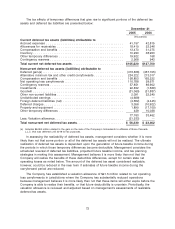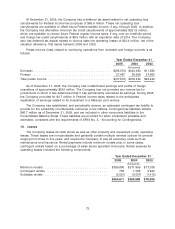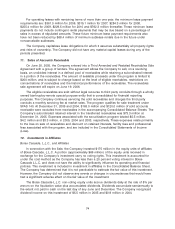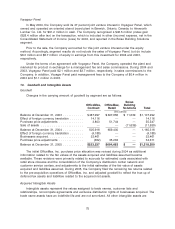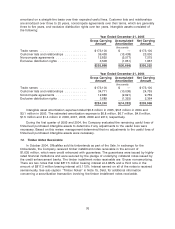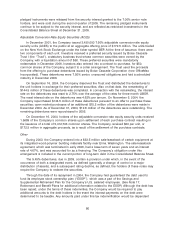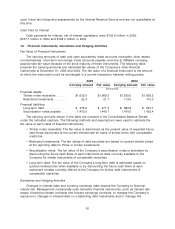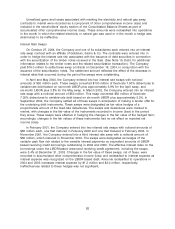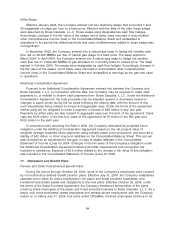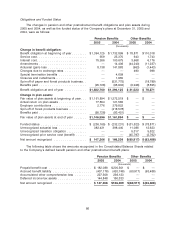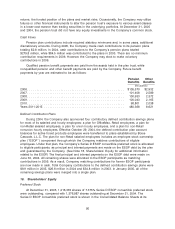OfficeMax 2005 Annual Report Download - page 86
Download and view the complete annual report
Please find page 86 of the 2005 OfficeMax annual report below. You can navigate through the pages in the report by either clicking on the pages listed below, or by using the keyword search tool below to find specific information within the annual report.Company’s exposure to changes in currency exchange rates. The Company generally does not
enter into derivative instruments for any purpose other than hedging the cash flows associated with
future interest payments on variable rate debt and hedging the exposure related to changes in the
fair value of certain outstanding fixed rate debt instruments due to changes in interest rates. The
Company occasionally hedges interest rate risk associated with anticipated financing transactions,
as well as commercial transactions and certain liabilities that are denominated in a currency other
than the currency of the operating unit entering into the underlying transaction. The Company does
not speculate using derivative instruments. At December 31, 2005, the Company was not a party to
any significant derivative instruments other than the Additional Consideration Agreement described
below.
The derivative financial instruments that the Company uses in its management of interest rate
risk consist principally of interest rate swap agreements. By using derivative financial instruments to
hedge exposures to changes in interest rates, the Company exposes itself to credit risk and market
risk. Credit risk is the risk that the counterparty will fail to perform under the terms of the derivative
contract. The Company minimizes the credit risk in derivative instruments by entering into
transactions only with investment grade counterparties. Market risk is the adverse effect on the
value of a financial instrument that results from a change in interest rates. The market risk
associated with interest rate contracts is managed by establishing and monitoring parameters that
limit the types and degree of market risk that may be undertaken.
The Company assesses its exposure to variability in interest rates by continually identifying and
monitoring changes in interest rates that may adversely impact future cash flows and the fair value
of existing debt instruments, and by evaluating hedging opportunities. The Company maintains risk
management control systems to monitor interest rate risk attributable to both the Company’s
outstanding and forecasted debt obligations as well as the Company’s offsetting hedge positions.
The risk management control systems involve the use of analytical techniques, including sensitivity
analysis, to estimate the expected impact of changes in interest rates on the fair value of the
Company’s outstanding and forecasted debt instruments.
The Company uses a combination of fixed and variable rate debt to finance its operations. The
debt obligations with fixed cash flows expose the Company to variability in the fair value of
outstanding debt instruments due to changes in interest rates. The Company has from time-to-time
entered into interest rate swap agreements that effectively convert the interest rate on certain
fixed-rate debt to a variable rate. The Company has designated these interest rate swap
agreements as hedges of the changes in fair value of the underlying debt obligation attributable to
changes in interest rates and accounts for them as fair value hedges. Changes in the fair value of
interest rate swaps designated as hedging instruments that effectively offset the variability in the fair
value of outstanding debt obligations are reported in operations. These amounts offset the gain or
loss (that is, the change in fair value) of the hedged debt instrument that is attributable to changes
in interest rates (that is, the hedged risk) which is also recognized currently in operations. The
Company has also from time-to-time entered into interest rate swap agreements that effectively
convert floating rate debt to a fixed rate obligation. These swaps have been designated as hedges
of floating interest rate payments attributable to changes in interest rates and are accounted for as
cash flow hedges, with changes in the fair value of the swap recorded to other comprehensive
income (loss) until the hedged transaction occurs, at which time it is reclassified to operations.
Prior to the Sale, the Company had a commodity-price risk management strategy that used
derivative instruments to minimize significant, unanticipated earnings fluctuations caused by energy
price volatility. The activities of the Company’s paper, forest products and building materials
businesses required a significant volume of electricity and natural gas. Price fluctuations in
electricity and natural gas could cause the actual purchase prices paid for energy to differ from
anticipated prices.
82


